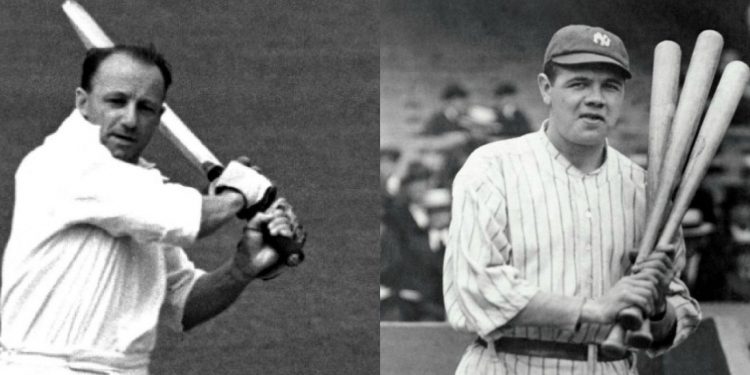Sir Donald Bradman’s private visit with Babe Ruth
During the two-month tour, Sir Don Bradman created a unique fusion between baseball and cricket. When it came to baseball, the legend met Babe Ruth of the New York Yankees, who was just as skilled as Bradman. As a result, he was frequently referred to as “Don Bradman of baseball.” Both of the greats hilariously assessed each other at this meeting, which took place at Yankee Stadium in the traditional baseball sense.
You’ve probably heard of Ripley’s Believe It or Not if you’re a huge fan of adventure and record-breaking television. Interestingly, aside from your passion for cricket, you must also savour the ethereal allure of India’s famous Taj Mahal, provided your inner history nerd hasn’t yet died. On Sunday, June 2, in New York, they will each become a unique part of history.
Before we continue to solve the puzzle, does the year 1844 suggest anything noteworthy about the forgotten past of cricket? Yes, indeed! In the history of the game, this year represents the oldest rivalry between two teams. This rivalry will grow when the United States of America (USA) plays their well-known adversary, Canada, in the opening match of the T20 World Cup in 2024. That is the main reason to bring it up.
The major question is: are Americans as conscious of the game and the occasion as people across the world are of the impending worldwide ICC mega cricket showdown? Since this won’t be your typical Major League Baseball (MLB) or Super Bowl event,. This involves bringing back memories of the past and identifying a suitable replacement for baseball in American culture.
There is an additional aspect of the T20 World Cup 2024 that many people are unaware of, as it brings to a close a new chapter in the history of global expansion. Many stories have been told about the greats of the game who, through their extraordinary sportsmanship and contributions to the game, ultimately achieved immortality. This led to the emergence of numerous names in the process, but Sir Donald Bradman’s name is one that frequently endures forever.
The best player to ever play the game, the iconic Australian, is much discussed, yet his legacy endures and has relevance to the upcoming T20 World Cup. The true inquiry concerns how and why the player who averages over 99 in the purest format has a fascinating background and a connection to changing cricket as a game. The USA’s historic World Cup debut in the T20I format against their neighbours is set to be on June 2. Because of this, cricket enthusiasts and analysts have already begun to argue about what the major cricket carnival will bring to the US over the course of almost a month.
In an attempt to transform Long Island into a unique location, the highest cricket regulating body has tried to extract all of its resources from its Saudi sponsors. Since Nassau County has a sizable international stadium standing in front of them with no indication of what will take place inside, the Americans who live nearby have found what they have seen in Kazoo to be amusing. Notably, supporters will have to cross a Ripley’s billboard and a Taj Mahal building just outside the stadium in order to enter the facility.
The Indian community, which will be supporting the world’s most popular cricket team, is doing everything in its power to spread awareness of the gentleman’s game in the United States as time is running out.
Given the unfavourable weather that has hampered the preparations for the major event, this attempt appears to have been abandoned; nonetheless, in order to comprehend why the USA and the rest of the world find this World Cup particularly significant, it is essential to investigate the unique relationship between the Bradman-T20 World Cup.
Special trip of the USA and Canada by Don Bradman
A unique event occurred in the history of cricket in July of 1932. After marrying his childhood sweetheart Jessie two months prior, Sir Donald Bradman—dubbed the “Babe Ruth” of cricket—arrived in the United States of America (USA) with mixed feelings and went on to play a major role in one of the most contentious cricket series in history, the “Bodyline” series. Oddly enough, Australian icon Arthur Mailey deserves all the credit for getting Bradman to visit the USA.
The aim of this unusual action was to bring back the declining popularity of cricket. Interestingly, the US promoted the tour as the “Don Bradman of Baseball” meeting the “Babe Ruth of Cricket.” It is noteworthy to highlight that Bradman was duped into boarding the Niagara cruise after Mailey referred to this excursion as an extended honeymoon for the newlyweds.
In addition, Sir Don participated in exhibition matches against the United States and Canada and against a Hollywood movie star squad that included actors like Ronald Colman, Leslie Howard, Clive Brook, and Boris Karloff. Aubrey Smith, a former England captain and accomplished cricketer who later turned actor, organised this cricket match.
Babe Ruth told Don Bradman that he would one day attempt cricket, and a few years later, he did just that. In 1934, Ruth knew he was coming toward the end of his baseball playing career. While he still put up great numbers that year, he was limited to 125 games pic.twitter.com/CTLVL13zUx
— Jim Koenigsberger (@Jimfrombaseball) May 6, 2022
Babe Ruth was taken aback upon meeting Donald Bradman, as he had previously assumed that the renowned Australian player must have possessed immense physical strength, leading to his unparalleled dominance in the sport. To his merriment, though, Bradman wasn’t very tall or muscular. Ruth, who was a startling six feet, two inches tall herself, still had not solved Sir Donald Bradman’s puzzle.
Ruth said, glancing at Bradman, “From what they were telling me, I thought you were a husky (big) and strong guy.”
Bradman, who was well-known for his fearless comedic reply, did, however, tell Ruth that short individuals like him are still capable of hitting balls harder and better than big guys. Bradman advised him not to hit the ball in the air too frequently in addition to that.
But we little guys are able to hit them more forcefully than the larger ones. When you hit the ball, sometimes you don’t have to run,” Bradman responded in a hilarious way.
Moreover, Babe Ruth had not yet encountered a mistake from the renowned Australian as their encounter developed. Ruth initially believed that the legend could hardly understand what was happening on the pitch and that Bradman had little knowledge of baseball and its rules. However, Bradman exuded his liquid grace to confound the baseball icon, as he was a true athlete with an abundance of game knowledge. Bradman exclaimed, “Jove!” as Ruth was still delineating the subtleties. A swindle of two!
Babe Ruth became strange as a result of having to abandon the hazy notion that he was ignorant of baseball’s intricacies. What transpired next, in case you’re still curious? Ruth, however, stated that Bradman no longer needs to be taught baseball.
“You yell “double-play” when I try to point out the game’s tricks? No instruction is necessary for you. Ruth responded, still a little surprised.
Bradman was an avid sports fan while growing up in Sydney, which may be an intriguing explanation for his exceptional athletic prowess. Bradman further felt that there were numerous parallels between baseball and cricket, which made it even easier for him to understand the subtleties.
Babe Ruth’s promise fulfilled, and two greats come to the end of an era
Following a string of accolades, Donald Bradman went on to establish himself as a capable administrator and author of an autobiography detailing his amazing cricket odyssey. Sir Don did not hold back while discussing the unique USA-Canada tour or his unwavering opinions on the “Bodyline” series in his well-known autobiography, “Farewell to Cricket.”
Bradman thought the tour was very taxing, but it was undoubtedly easier than having to deal with England’s infamous “bodyline” tactic against his players during the 1932–1933 Ashes Tour to Australia.
Bradman wrote, recalling the series and the special tour, “It had been far too strenuous, but nevertheless it was placid compared with the storm that lay ahead, and of which at that time we had scarcely heard the rumblings.”
Babe Ruth had told Sir Donald Bradman that he would give cricket a try, even if the two legends never crossed paths again. Bradman did, however, achieve this goal, if only briefly. The Bambino, often known as Babe Ruth, played in 125 baseball games in 1934, showing off his flawless scoring consistency just as he was about to call it a day on his remarkable baseball career. Ruth played with the legendary Yankees for 34 seasons before leaving for a global tour that stopped in London. He got in touch with former Australian cricket player Alan Fairfax during this break.
Ruth struggled at bat at first, even after Fairfax had taught him the fundamentals of stance and hitting. However, the Pinstripes veteran once again displayed his mastery of clean hitting as he reverted to his baseball stance and attacked the bowlers with all of his might. Subsequently, as he considered playing cricket, he discovered that the salary of cricket players was a meagre 20 pounds, significantly less than his current baseball salary. He returned to the United States and gave up on his dream of playing cricket.
Strangely enough, two days before Sir Donald Bradman ended his illustrious cricket career, on August 16, 1948, Babe Ruth passed away. This was a coincidence that occurred after Ruth had played baseball for a long time. Bradman, on the other hand, failed to get going and was out for a duck in his final knock. Bradman needed just four more runs to finish his career on a flawless over-a-century average.
In conclusion
Parallel to this, modern cricket legends such as India’s skipper Rohit Sharma and star batsman Virat Kohli will undoubtedly give it their all in what may be their final World Cup before ending their extraordinary careers when the highly anticipated ICC T20 World Cup 2024 gets underway tomorrow, Sunday, June 2. In addition, other notable cricket players and nations, such as Australia and England, can make significant contributions to bringing cricket back to the forefront of American culture. As a perfect testament and homage to cricket’s greatness, Sir Donald Bradman, Pat Cummins, Jos Buttler, and the West Indies, who are co-hosting the Twenty20 World Cup, may all play a part in extending and resurrecting the sport’s past grandeur.






